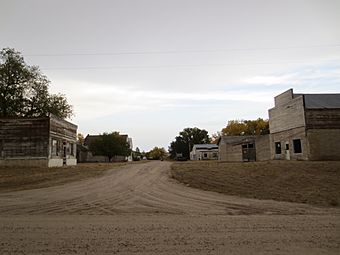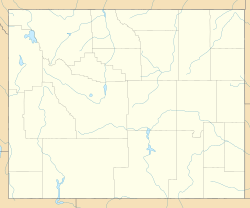Jay Em Historic District facts for kids
Quick facts for kids |
|
|
Jay Em Historic District
|
|
 |
|
| Location | Main St., Jay Em, Wyoming |
|---|---|
| Built | 1915 |
| Architect | Harris, Lake |
| NRHP reference No. | 84003665 |
| Added to NRHP | April 12, 1984 |
The Jay Em Historic District is an old, empty village in Jay Em, Wyoming. It was planned and built by a man named Lake Harris between 1912 and 1915. The town was meant to help ranchers in the area by providing services. In 1915, a post office opened there, which officially made it a town. Today, you can visit the site by making an appointment.
Contents
History of Jay Em
Early Days and the Texas Trail
Jay Em is located on an old path called the Texas Trail. This trail ran north and south through Goshen County. It was an important route for moving cattle. Jay Em had the very last watering hole before cowboys and their cattle reached Lusk.
In the 1860s, a man named Jim Moore claimed the land around this watering hole. By 1869, his cattle ranch was the second largest in the Wyoming Territory. His ranch used a special symbol called a "J Rolling M" brand. This brand gave its name to a small stream nearby, which became known as "Jay Em Creek." Jim Moore passed away in 1875, but his ranch brand continued to be used.
The Harris Family Arrives
In 1905, Silas Harris and his three sons took over the Jay Em Cattle Company. One of his sons, Lake Harris, was very important to the town's story. He set up a post office in the bunkhouse (where ranch workers slept) at the Jay Em Ranch. This meant mail could be brought from Rawhide Buttes to the ranch. The Harris family also opened a general store right there on the ranch.
Building the Town of Jay Em
In 1912, Lake Harris decided to build a small town. He filed a claim for land near Rawhide Creek. He started by building his own house. Next, he built a feed store, which became the new home for the post office in 1915.
The Harris family's general store moved into the new town of Jay Em in 1918. Soon after, Lake Harris built another store for lumber and general supplies. From 1917 to 1921, a weekly newspaper called the Jay Em Sentinel and Fort Laramie News was published. Lake Harris was the editor, and about 300 copies were printed each week. In 1920, the Farmers State Bank was built in Jay Em.
Growth and Decline
Throughout the 1920s and 1930s, Jay Em was an important center for business in northern Goshen County. In 1935, Lake Harris started the Jay Em Stone Company. This company made tombstones and building materials from stone found near the Rawhide Buttes.
However, after the 1930s, Jay Em began to shrink. More and more people had cars, which made it easy for them to drive to bigger towns for shopping and services. The general store in Jay Em stayed open until the late 1970s. Lake Harris, the man who built the town, lived a long life and passed away in 1983 at the age of 96.
Today, the few people who still live in Jay Em have moved to newer homes around the edge of the town. This has left the original center of Jay Em empty.
Important Buildings in Jay Em
Many of the old buildings in Jay Em are still standing. They show what life was like in this historic town.
- Restaurant-Feed Store-Post Office-General Store: This was a very busy building! It was made of two large buildings with special "gambrel" roofs. These two parts were connected by a smaller, flat-roofed section.
- Lumber Yard: The lumber yard had a main sales building that looked taller than it was (a "false front"). Behind it was a warehouse, with a courtyard in between. The sales building was made of concrete blocks, and the warehouse was mostly wood.
- Stone Company: This building was made of brick and had a pointed roof with smaller, sloped roofs on the sides. The front had fifteen windows with special concrete frames and decorated tops.
- Bank: This was a small, one-story wooden building. It had a low, decorated front.
- Gas Station: This was a one-story wooden building. The front part of the roof stuck out to create a covered area for cars to drive through while getting gas.
- Repair Garage: This was a one-story building with a stepped front that looked like stairs. It was decorated with round ornaments on top.
- House: This was a one-story wooden house built on a concrete block foundation.
- Water Tower: This structure is now damaged and missing its tank. It stands about 60 feet (18 meters) tall.
- Lake Harris House: This was Lake Harris's home. It had parts that were one story tall and parts that were two stories tall. The house was built over an original dugout (a shelter dug into the ground). You can still see a special "owl wall" inside.
The Jay Em Historic District was added to the National Register of Historic Places in 1984. This means it is recognized as an important historical site.
Images for kids




